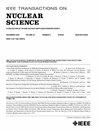自供电中子探测器空间电荷效应演化的分析方法
IF 1.9
3区 工程技术
Q3 ENGINEERING, ELECTRICAL & ELECTRONIC
引用次数: 0
摘要
自供电中子探测器(SPND)绝缘子中的空间电荷效应作为影响探测器性能的关键因素之一,一直是研究的热点。以往的研究提供了迭代仿真算法;然而,这些算法耗时且效率低下,并且不能直接解释探测器参数和中子通量如何影响空间电场及其演变。因此,我们首次提出了一种计算空间电荷效应的解析方法。该方法提供了空间电荷分布演化的解析表达式,显著提高了计算效率。解析表达式表明,空间电荷分布与绝缘子的中子通量密度、体电阻率和介电常数成正比,证实了以往数值研究的结果。此外,本文还首次提出了一种计算空间电荷演化时间常数的方法。基于该时间常数,可以预测电场平衡时间,为迭代计算中时间步长的预设提供指导。对钴SPND (Co-SPND)和铑SPND (Rh-SPND)进行了分析预测和迭代计算的比较。解析模型的计算结果与迭代模型的计算结果一致,证明了所提出的解析方法的准确性。本文章由计算机程序翻译,如有差异,请以英文原文为准。
An Analytical Method for Evaluating the Evolution of Space Charge Effect in Self-Powered Neutron Detectors
The space charge effect in self-powered neutron detector (SPND) insulators, as one of the key factors affecting detector performance, has always been a focus of research. Previous studies have provided iterative simulation algorithms; however, these algorithms are time-consuming and inefficient and do not directly explain how the detector parameters and neutron flux affect the space electric field and its evolution. Therefore, for the first time, we propose an analytical method to calculate the space charge effect. This method provides an analytical expression for the evolution of the space charge distribution, significantly improving computational efficiency. The analytical expression reveals that the space charge distribution is proportional to the neutron flux density, bulk resistivity, and dielectric constant of the insulator, which confirms the results from the previous numerical studies. Moreover, this work presents a method for calculating the time constant of the space charge evolution for the first time. Based on this time constant, the electric field equilibrium time can be predicted, providing guidance for presetting the time step in iterative calculations. Comparisons between the analytical predictions and iterative calculations were conducted for both cobalt SPND (Co-SPND) and rhodium SPND (Rh-SPND). The results from the analytical model and from the iterative model are consistent, demonstrating the accuracy of this proposed analytical method.
求助全文
通过发布文献求助,成功后即可免费获取论文全文。
去求助
来源期刊

IEEE Transactions on Nuclear Science
工程技术-工程:电子与电气
CiteScore
3.70
自引率
27.80%
发文量
314
审稿时长
6.2 months
期刊介绍:
The IEEE Transactions on Nuclear Science is a publication of the IEEE Nuclear and Plasma Sciences Society. It is viewed as the primary source of technical information in many of the areas it covers. As judged by JCR impact factor, TNS consistently ranks in the top five journals in the category of Nuclear Science & Technology. It has one of the higher immediacy indices, indicating that the information it publishes is viewed as timely, and has a relatively long citation half-life, indicating that the published information also is viewed as valuable for a number of years.
The IEEE Transactions on Nuclear Science is published bimonthly. Its scope includes all aspects of the theory and application of nuclear science and engineering. It focuses on instrumentation for the detection and measurement of ionizing radiation; particle accelerators and their controls; nuclear medicine and its application; effects of radiation on materials, components, and systems; reactor instrumentation and controls; and measurement of radiation in space.
 求助内容:
求助内容: 应助结果提醒方式:
应助结果提醒方式:


